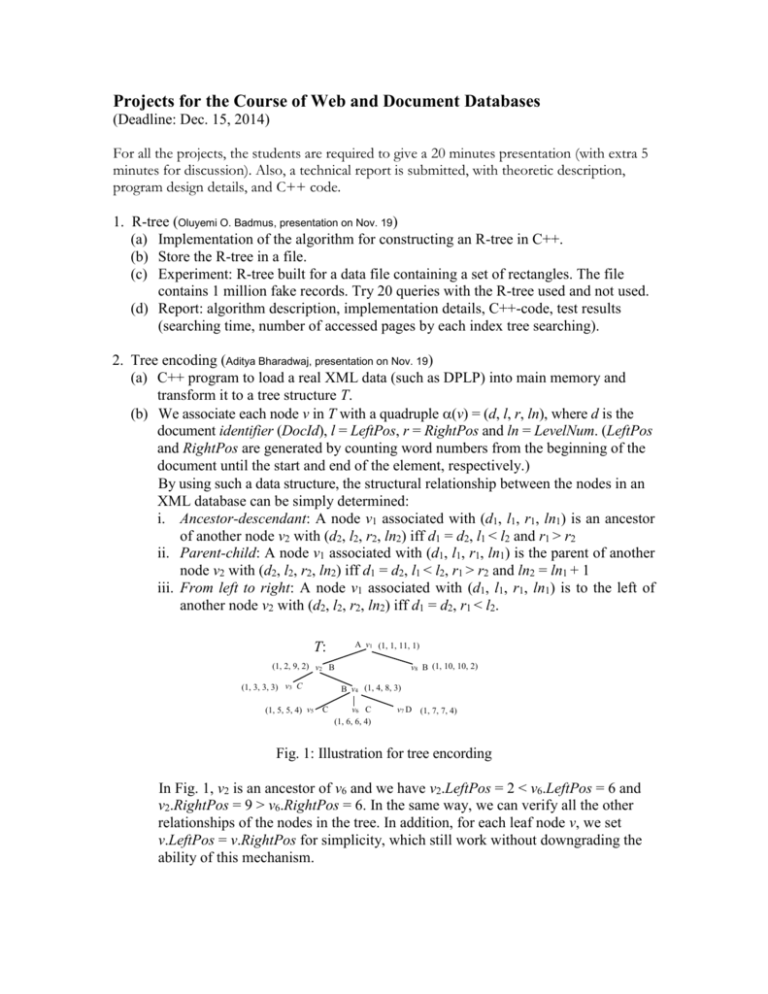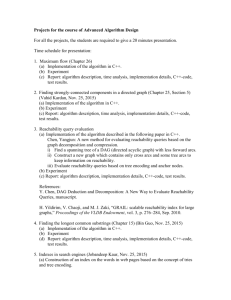Projects for the course of Web and Document Databases
advertisement

Projects for the Course of Web and Document Databases (Deadline: Dec. 15, 2014) For all the projects, the students are required to give a 20 minutes presentation (with extra 5 minutes for discussion). Also, a technical report is submitted, with theoretic description, program design details, and C++ code. 1. R-tree (Oluyemi O. Badmus, presentation on Nov. 19) (a) Implementation of the algorithm for constructing an R-tree in C++. (b) Store the R-tree in a file. (c) Experiment: R-tree built for a data file containing a set of rectangles. The file contains 1 million fake records. Try 20 queries with the R-tree used and not used. (d) Report: algorithm description, implementation details, C++-code, test results (searching time, number of accessed pages by each index tree searching). 2. Tree encoding (Aditya Bharadwaj, presentation on Nov. 19) (a) C++ program to load a real XML data (such as DPLP) into main memory and transform it to a tree structure T. (b) We associate each node v in T with a quadruple (v) = (d, l, r, ln), where d is the document identifier (DocId), l = LeftPos, r = RightPos and ln = LevelNum. (LeftPos and RightPos are generated by counting word numbers from the beginning of the document until the start and end of the element, respectively.) By using such a data structure, the structural relationship between the nodes in an XML database can be simply determined: i. Ancestor-descendant: A node v1 associated with (d1, l1, r1, ln1) is an ancestor of another node v2 with (d2, l2, r2, ln2) iff d1 = d2, l1 < l2 and r1 > r2 ii. Parent-child: A node v1 associated with (d1, l1, r1, ln1) is the parent of another node v2 with (d2, l2, r2, ln2) iff d1 = d2, l1 < l2, r1 > r2 and ln2 = ln1 + 1 iii. From left to right: A node v1 associated with (d1, l1, r1, ln1) is to the left of another node v2 with (d2, l2, r2, ln2) iff d1 = d2, r1 < l2. A v1 (1, 1, 11, 1) T: (1, 2, 9, 2) v2 B (1, 3, 3, 3) v3 C (1, 5, 5, 4) v5 v8 B (1, 10, 10, 2) B v4 (1, 4, 8, 3) C v6 C (1, 6, 6, 4) v7 D (1, 7, 7, 4) Fig. 1: Illustration for tree encording In Fig. 1, v2 is an ancestor of v6 and we have v2.LeftPos = 2 < v6.LeftPos = 6 and v2.RightPos = 9 > v6.RightPos = 6. In the same way, we can verify all the other relationships of the nodes in the tree. In addition, for each leaf node v, we set v.LeftPos = v.RightPos for simplicity, which still work without downgrading the ability of this mechanism. (c) For the purpose of experiments, download an XML document from http://www.cs.washington.edu/research/xmldatasets, and then transform it to a tree structure. (d) Report: algorithm description, implementation details, C++-code, test results. 3. Reachability checking (Abukari Mohammed Yakubu) (a) Read paper: H. Yildirim, V. Chaoji, and M.J. Zaki, GRAIL: Scalable Reachability Index for Large Graphs, in Proc. VLDB Endowment, 3(1), 2010, pp. 276-284. Summarize its main idea. (b) The code of the method discussed in the paper can be found in: http://www.cs.rpi.edu/~zaki/www-new/pmwiki.php/Software/Software#toc18 (c) Run the code against some graphs, which can be found in web sites listed in the paper. (d) Report: algorithm description, test results. 4. Simple searching engine (Ajay Ramganesh, presentation on Nov. 19) (a) C++ program to get web pages for a set of URLs (programs are available). (b) Create an inverted file for all the low-frequency words, and a signature tree for all the high- and –middle frequency words over the obtained web pages. (c) Try 20 key queries against the web pages. (d) Report: algorithm description, implementation details, C++-code, test results (such as the number of different words in all documents, sizes of established inverted files and signature trees). 5. XML document storage (Manish Sharma, presentation on Nov. 24) (a) C++ program to store XML documents in four files (tables) with the following formats: DocRoot(docID, rootElmentID) SubElement(parented, childID, position) ElementAttribute(elementID, name, value) ElementValue(elementID, value) (b) Work on a database system such as Access, or SQL server, and transform some simple XPath expressions to SQL queries, evaluate them against your database. (c) Report: algorithm description, implementation details, C++-code, test results. 6. Reachability checking (Orlando K. Simpson, presentation on Nov. 24) (a) Read paper: Sebastiaan J. van Schaik and Oege de Moor. A memory efficient reachability data structure through bit vector compression. In SIGMOD ‘11: Proceedings of the 37th SIGMOD international conference on Management of data, pages 913-924, New York, NY, USA, 2011. Summarize its main idea. (b) The code of the method discussed in the paper can be found in: http://www.sjvs.nl/?p=72. (c) Run the code against some graphs, which can be found in web sites listed in the paper. (d) Report: algorithm description, test results. 7. Bitmap (Bakul Trehan, presentation on Nov. 24) (a) C++ program to generate bit-vectors for a data file over two numeric attributes. The file contains 1 million fake records. (b) Compressing bit vectors. (c) Experiment on the query time and space overhead. (d) Report: algorithm description, implementation details, C++-code, test results. 8. Quad-tree (Ashish Tripathi, presentation on Nov. 26) (a) C++ program to generate a quad-tree for a data file over two numeric attributes. The file contains 1 million fake records. (b) Store the quad-tree in a file. (c) Experiment: quad-tree built for a data file over two numeric attributes. The file contains 1 million fake records. Try 20 queries with the quad-tree used and not used. (d) Report: algorithm description, implementation details, C++-code, test results. 9. B+-tree (Abayomi Awe, presentation on Nov. 26) (a) Implementation of the algorithm for constructing a B+-tree in C++. (b) Store the B+-tree in a file. (c) Experiment: B+-tree built for a data file over a numeric key. The file contains 1 million fake records. Try 20 queries with the B+-tree used and not used. (d) Report: algorithm description, implementation details, C++-code, test results. 10. Index over intervals (a) Implementation of an algorithm for constructing a variant of the B+-tree over intervals in C++. (b) The intervals can be created as follows: - First, create a tree T. - Then, generate intervals for the nodes in T as below. We can assign each node v in T an interval [v, v), where v is v’s preorder number (denoted pre(v)) and v - 1 is equal to the largest preorder number among all the nodes in T[v]. So another node u labeled [u, u) is a descendant of v (with respect to T) iff u [v, v), as illustrated in Fig. 2. If u [v, v), we say, [u, u) is subsumed by [v, v). This method is called the tree labeling. a [0, 13) r [6, 10) b [1, 6) d [2, 5) c [3, 5) p [4, 5) k e [5, 6) h f j [7, 10) i g [8, 9) [10, 13) [11, 12) [12, 13) [9, 10) Fig. 2: A spanning tree and intervals A B+-tree over intervals can be established in a way similar to B+-tree trees, but over intervals, as shown in Fig. 3. p.parentIndex (1, 9) (2, 7) (3, 3) (4, 6) (5, 5) (8, 8) P1 1, 9 3, 6 5, 8 p.parent P2 P3 1, 9 2, 7 (a) P4 3, 3 4, 6 5, 5 8, 8 (b) Fig. 3: An interval sequence and XB-tree over it In such an index structure, each entry in a page is a pair a = (LeftPos, RightPos) (referred to as a bounding segment) such that any entry appearing in the subtree pointed to by the pointer associated with a is subsumed by a. In addition, all the entries in a page are sorted by their LeftPos values. In each page P of an XB-tree, the bounding segments may partially overlap, but their LeftPos positions are in increasing order. Let a1 and a2 be two consecutive entries. Then the leftPos value of any entry in the subtree rooted at a1 is smaller than the leftPos value of a2. For instance, in the XB-tree shown in Fig. 3(b), the first entry of P1: [1, 9] overlaps the second entry: [3, 6]. But the leftPos value of any entry in the subtree rooted at [1, 9] is smaller than 3. Besides, it has two extra data fields: P.parent and P.parentIndex. P.parent is a pointer to the parent of P, and P.parentIndex is a number i to indicate that the ith pointer in P.parent points to P. For instance, in the XB-tree shown in Fig. 3(b), P3.parentIndex = 2 since the second pointer in P1 (the parent of P3) points to P3. (c) For the purpose of experiments, download an XML document from http://www.cs.washington.edu/research/xmldatasets, and then transform it to a tree structure. (d) Report: algorithm description, implementation details, C++-code, test results (searching time, number of accessed pages by each index tree searching). 11. Unordered tree matching (a) Implementation of an algorithm for evaluating unordered tree pattern queries in C++. (b) Experiments on some tree patterns represented as XPath expressions. (c) Report: algorithm description, implementation details, C++-code, test results. Guidance to project reports: 1. Introduction (including the problem description, motivation – its significance and application in the computer engineering and industry) 2. Related work (describe some important techniques related to the problem to be addressed) 3. Main thrust (detailed description of the method, formal algorithm, analysis of computational complexities: time and space overhead) 4. Experiments (main data structures used for implementation, description of the data used for tests, test results: charts, histogram, or tables) 5. Future work (discussion on the possible improvements, or possible extension) 6. References








